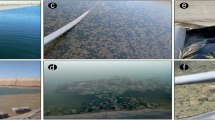Abstract
In stratified lakes with high light penetration, the maximum depth at which macrophytes occur is frequently limited by temperature. At this depth a variety of species may be found. On the other hand, when the clarity of water limits the light penetration and the temperature at depth is sufficient for good plant growth, the plants occurring at greatest depth are ones that do not require photosynthetic oxygen for root growth. Such plants include the Charales, Isoetes, Utricularia and Ceratophyllum.
Similar content being viewed by others
References
Aiken, S. & J. M. Gillett, 1974. The distribution of aquatic plants in selected lakes of Gatineau Park, Quebec. Can. Fld. Nat. 88: 437–448.
Anderson, R. R., 1969. Temperature and rooted aquatic plants. Chesapeake Sci. 10: 157–164.
Barko, J. W., D. G. Hardin & M. S. Matthews, 1982. Growth and morphology of submersed freshwater macrophytes in relation to light and temperature. Can. J. Bot. 60: 877–887.
Barko, J. W. & R. M. Smart, 1981. Comparative influences of light and temperature on the growth and metabolism of selected submersed fresh water macrophytes. Ecol. Monogr. 51: 219–235.
Boylen, C. W. & R. B. Sheldon, 1976. Submergent macrophytes: growth under winter ice cover. Science 194: 841–842.
Crawford, R. M. M., 1978. Metabolic adaptations to anoxia. In: D. D. Hook & R. M. M. Crawford (eds). Plant life in anaerobic environments. Ann Arbor Science Publishers Inc., Ann Arbor, Mich. 119–136.
Dale, H. M., 1981. Hydrostatic pressure as the controlling factor in the depth distribution of Eurasian watermilfoil Myriophyllum spicatum L. Hydrobiologia 70: 239–244.
Dale, H. M., 1984. Hydrostatic pressure and aquatic plant growth: a laboratory study. Hydrobiologia 111: 193–200.
Dale, H. M. & T. J. Gillespie, 1977. The influence of submersed aquatic plants on temperature gradients in shallow water bodies. Can. J. Bot. 55: 2216–2225.
Hitchin, G. G., I. Wile, G. E. Miller & N. D. Yan, 1984. Macrophyte data from 46 southern Ontario soft-water lakes of varying pH. Ont. Minist. Envir., Wat. Resour. Branch, Data Rep. DR 84/2. 26 p. + Appendix, 46 figs. & 46 tables.
Hutchinson, G. E., 1975. A treatise on limnology, 3. Limnological Botany. John Wiley & Sons, Toronto, 660 pp.
Karrfalt, E. E., 1977. Substrate penetration by the corm of Isoetes. Am. Fern J. 67: 1–4.
Moeller, R. E., 1980. The temperature-determined growing season of a submerged hydrophyte: tissue chemistry and biomass turnover of Ultricularia purpurea. Freshwat. Biol. 10: 391–400.
Nicholson, S. A., R. A. Levey & P. R. Clute, 1974. Macrophytesediment relationships in Chautauqua Lake. Verh. int. Ver. Limnol. 19: 2758–2764.
Paolillo, D. J., 1963. The developmental anatomy of Isoetes. Ill. biol. Monogr. 31, University of Illinois Press, Urbana. 130 p.
Reid, R. A., R. Girard & B. Locke, 1983. Temperature profiles on the Muskoka-Haliburton Lakes (1976–1982). Ont. Minist. Envir. Data Rep. 83/4. 6 pp. + 56 figs.
Sheldon, R. B. & C. W. Boylen, 1977. Maximum depth inhabited by aquatic vascular plants. Am. Midl. Nat. 97: 248–254.
Singer, R., A. A. Roberts & C. N. Boylen, 1983. The macrophytic community of an acid lake in Adirondack (New York, U.S.A.): A new depth record for aquatic angiosperms. Aquat. Bot. 16: 49–57.
Smith, R. D., W. C. Dennison & R. S. Alberte, 1984. Role of Seagrass photosynthesis in root aerobic processes. Pl. Physiol. 74: 1055–1058.
Spence, D. H. N., 1981. The zonation of plants in freshwater lakes. Adv. ecol. Res. 12: 37–125.
Spence, D. H. M. & H. M. Dale, 1978. Variations in the shallow water form of Potamogeton richardsonii induced by some environmental factors. Freshwat. Biol. 8: 251–268.
Wetzel, R. G., 1975. Limnology. W.B. Saunders Co., Toronto, 743 pp.
Wile, I. & G. E. Miller, 1983. The macrophyte flora of 46 acidified and acid-sensitive soft-water lakes in Ontario. Limnol. Sect., Ont. Minist. Envir., 34 pp.
Wilson, L. R., 1941. The larger aquatic vegetation of Trout Lake, Vilas County, Wisconsin. Trans. Wisc. Acad. Arts, Sci. Lett. 33: 133–146.
Author information
Authors and Affiliations
Rights and permissions
About this article
Cite this article
Dale, H.M. Temperature and light: The determining factors in maximum depth distribution of aquatic macrophytes in Ontario, Canada. Hydrobiologia 133, 73–77 (1986). https://doi.org/10.1007/BF00010804
Received:
Accepted:
Issue Date:
DOI: https://doi.org/10.1007/BF00010804




